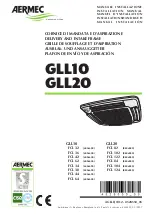
32
Outdoor Unit
Refrigerant piping installation
(2) Vacuum
Vacuum drying should be made from the service port provided on the outdoor unit’s service valve to the vac-
uum pump commonly used for liquid pipe, gas pipe. Vaccum of the pipe and the indoor units should be
made from the port of the outdoor unit's service valve with the service valve closed.
* Never perform air purging using refrigerant.
• Vacuum drying: Use a vacuum pump that can evacuate to -100.7kPa (5 Torr, -755mmHg).
1) Evacuate the system from the liquid and gas pipes with a vacuum pump for over 2 hrs and bring the sys-
tem to -100.7kPa.
After maintaining system under that condition for over 1 hr, confirm the vacuum gauge rises. The system
may contain moisture or leak.
2) Following should be executed if there is a possibility of moisture remaining inside the pipe.
(Rainwater may enter the pipe during work in the rainy season or over a long period of time)
After evacuating the system for 2 hrs, give pressure to the system to 0.05MPa(vacuum break) with nitro-
gen gas and then evacuate it again with the vacuum pump for 1hr to -100.7kPa(vacuum drying). If the
system cannot be evacuated to -100.7kPa within 2 hrs, repeat the steps of vacuum break and its drying.
Finally, check if the vacuum gauge does not rise or not, after maintaining the system in vacuum for 1 hr.
Vacuum pump
Liquide pipe
Gas pipe
WARNING
• If the primary charging is not performed after vacuum, wet air may go into the outdoor unit. If air is mixed with the
refrigerant, the refrigerant cycle may malfunction and the unit may be damaged.
• Charging of refrigerant while the compressor is working is prohibited. Otherwise, liquid may go into the compres-
sor. It may cause faults of the compressor.
• Use a gravimeter accurate to 0.1kg.
• If other refrigerants are mixed in the original refrigerant, a refrigerant cycle may cause malfunction or damage.
• Add accurate refrigerant quantity via calculation.
Too much or too little refrigerant may cause problems
• Repeated on and off of the indoor units without charging refrigerant may cause faults of EEV.
• Since R410A is a mixed refrigerant, the required additional refrigerant must be charged in its liquid state. If the
refrigerant is charged in its gaseous state, its composition changes and the system will not work properly.
















































